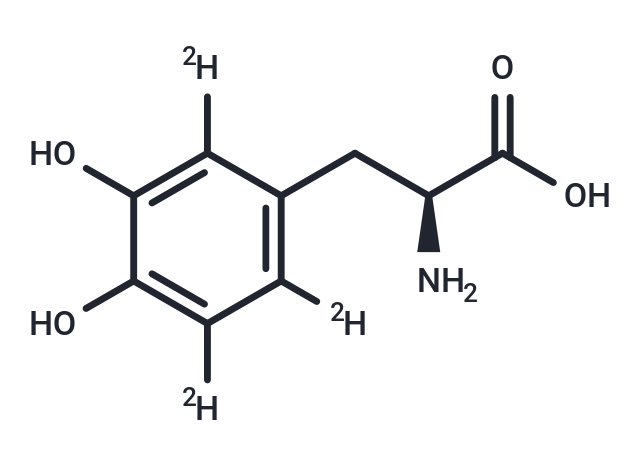- Remove All
 Your shopping cart is currently empty
Your shopping cart is currently empty
L-Dopa-2,5,6-d3
L-Dopa-2,5,6-d3 is a deuterated compound of L-Dopa. L-Dopa has a CAS number of 59-92-7. Levodopa is an amino acid precursor of dopamine with antiparkinsonian properties. Levodopa is a prodrug that is converted to dopamine by DOPA decarboxylase and can cross the blood-brain barrier. When in the brain, levodopa is decarboxylated to dopamine and stimulates the dopaminergic receptors, thereby compensating for the depleted supply of endogenous dopamine seen in Parkinson's disease. To assure that adequate concentrations of levodopa reach the central nervous system, it is administered with carbidopa, a decarboxylase inhibitor that does not cross the blood-brain barrier, thereby diminishing the decarboxylation and inactivation of levodopa in peripheral tissues and increasing the delivery of dopamine to the CNS.

L-Dopa-2,5,6-d3
| Pack Size | Price | Availability | Quantity |
|---|---|---|---|
| 1 mg | Inquiry | 20 days | |
| 5 mg | Inquiry | 20 days |
Product Introduction
| Description | L-Dopa-2,5,6-d3 is a deuterated compound of L-Dopa. L-Dopa has a CAS number of 59-92-7. Levodopa is an amino acid precursor of dopamine with antiparkinsonian properties. Levodopa is a prodrug that is converted to dopamine by DOPA decarboxylase and can cross the blood-brain barrier. When in the brain, levodopa is decarboxylated to dopamine and stimulates the dopaminergic receptors, thereby compensating for the depleted supply of endogenous dopamine seen in Parkinson's disease. To assure that adequate concentrations of levodopa reach the central nervous system, it is administered with carbidopa, a decarboxylase inhibitor that does not cross the blood-brain barrier, thereby diminishing the decarboxylation and inactivation of levodopa in peripheral tissues and increasing the delivery of dopamine to the CNS. |
| Molecular Weight | 200.21 |
| Formula | C9H8D3NO4 |
| Cas No. | 53587-29-4 |
| Storage | Shipping with blue ice. |
Calculator
In Vivo Formulation Calculator (Clear solution)
Dose Conversion
Tech Support

Copyright © 2015-2025 TargetMol Chemicals Inc. All Rights Reserved.




